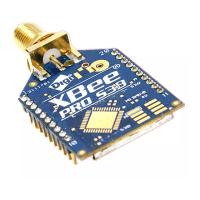Advanced application features Network commissioning and diagnostics
XBee®-PRO 900HP/XSC RF Modules
165
If the result field is not equal to zero then an error occurred. Ignore the other fields in the packet. If
the Success field is equal to zero then ignore the RSSI fields.
Trace routing
Determining the route a DigiMesh unicast takes to its destination is useful when setting up a network
or diagnosing problems within a network. Use the Trace Route API option of Tx Request Packets to
transmit routing information packets to the originator of a DigiMesh unicast by the intermediate
nodes. For a description of the API frames, see API operating mode.
If you enable the Trace Route API option, the device sends the unicast to its destination devices, which
forward the unicast to its eventual destination. The destination devices transmit a Route Information
(RI) packet back along the route to the unicast originator.
When a unicast is sent with the Trace Route API option enabled, the unicast is sent to its destination
radios which forward the unicast to its eventual destination and transmit a Route Information (RI)
packet back along the route to the unicast originator. For more information, see API operating mode.
The destination devices contain addressing information for the unicast and intermediate hop that
generates the trace route packet, and other link quality information.
Example:
Suppose you unicast a data packet with the trace route enabled from radio A to radio E, through
radios B, C, and D. The following sequence occurs:
n After the successful MAC transmission of the data packet from A to B, A outputs an RI Packet
indicating that the transmission of the data packet from A to E was successfully forwarded one
hop from A to B.
n After the successful MAC transmission of the data packet from B to C, B transmits a RI Packet
to A. Then, A outputs this RI packet out its serial interface.
n After the successful MAC transmission of the data packet from C to D, C transmits a RI Packet
to A (through B). Then, A outputs this RI packet out its serial interface.
n After the successful MAC transmission of the data packet from D to E, D transmits an RI Packet
to A (through C and B). Then, A outputs this RI packet out its serial interface.
Route Information packets are not guaranteed to arrive in the same order as the unicast packet took.
It is also possible Route Information packets that are transferred on a weak route to fail before
arriving at the unicast originator.
Because of the large number of Route Information packets that can be generated by a unicast with
Trace Route enabled, we suggest that the Trace Route option only be used for occasional diagnostic
purposes and not for normal operations.
NACK messages
Transmit Request (0x10 and 0x11) frames contain a negative-acknowledge character (NACK) API
option (Bit 2 of the Transmit Options field).
If you use this option when transmitting data, when a MAC acknowledgment failure occurs on one of
the hops to the destination device, the device generates a Route Information Packet (0x8D) frame
and sends it to the originator of the unicast.
This information is useful because it allows you to identify and repair marginal links.
Commissioning pushbutton and associate LED
XBee devices support a set of commissioning pushbutton and LED behaviors to aid in device
deployment and commissioning. These include the commissioning push button definitions and

